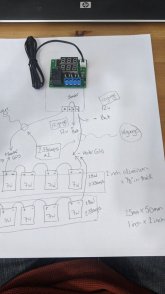Up here in New Hampshire, we haven't had the both sun out and temp above 32ºF at the same time for weeks. Thinking about possible heating solutions after reading this entire thread. Here is my plan...
For each battery pack (24V, 8 x 176Ah cells), place a sheet of 1/4" aluminum underneath. Under the aluminum, glue two of those
Hive Heaters previously mentioned. They are 12V 1A each - wire in series so I can run directly from 24V. Have to some shims of aluminum on the underside as well so the heating pads don't get too crushed. Thinking about a layer of Kapton tape on the top surface of the aluminum as an additional electrical insulator. I don't think the aluminum cell bodies are electrically connected, but just to be sure. Repeat for each of the three parallel packs.
I am only interested in heating while charging - my BMS has separate charge and discharge cuts-off temps, and the discharge is much lower.
I also have a
Simarine monitoring system and some of the shunts have programmable relays built in. So the plan is to have a high amperage relay control the heating pads' 24V supply. A 3PDT relay would allow putting one pack heater assembly on each contact for plenty of current margin, something like
this. That relay would be triggered by two of the Simarine relays in series. The first programmed for temp under 35ºF and the second for solar charge controller amperage over about 1.5A. So the heaters would come on only when it is both cold enough, and I am getting enough current from solar to offset the heater loss and still have some left to do charging. Don't want the heaters running at night when there is no charging happening anyway.
Already ordered the heating pads and relay. Should have something testable in a week or so.






